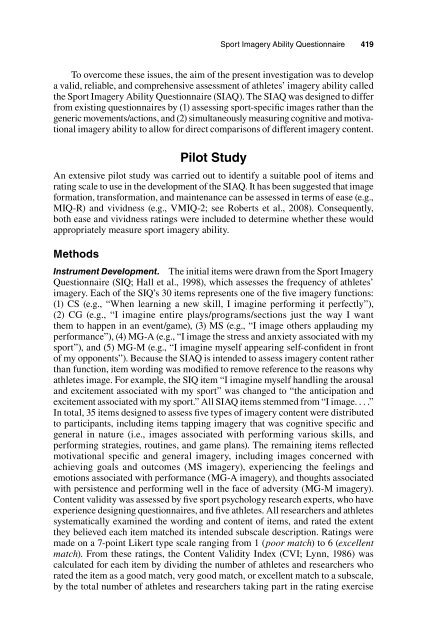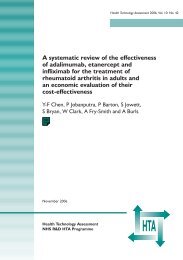Measuring Athlete Imagery Ability: The Sport ... - ResearchGate
Measuring Athlete Imagery Ability: The Sport ... - ResearchGate
Measuring Athlete Imagery Ability: The Sport ... - ResearchGate
Create successful ePaper yourself
Turn your PDF publications into a flip-book with our unique Google optimized e-Paper software.
<strong>Sport</strong> <strong>Imagery</strong> <strong>Ability</strong> Questionnaire 419<br />
To overcome these issues, the aim of the present investigation was to develop<br />
a valid, reliable, and comprehensive assessment of athletes’ imagery ability called<br />
the <strong>Sport</strong> <strong>Imagery</strong> <strong>Ability</strong> Questionnaire (SIAQ). <strong>The</strong> SIAQ was designed to differ<br />
from existing questionnaires by (1) assessing sport-specific images rather than the<br />
generic movements/actions, and (2) simultaneously measuring cognitive and motivational<br />
imagery ability to allow for direct comparisons of different imagery content.<br />
Pilot Study<br />
An extensive pilot study was carried out to identify a suitable pool of items and<br />
rating scale to use in the development of the SIAQ. It has been suggested that image<br />
formation, transformation, and maintenance can be assessed in terms of ease (e.g.,<br />
MIQ-R) and vividness (e.g., VMIQ-2; see Roberts et al., 2008). Consequently,<br />
both ease and vividness ratings were included to determine whether these would<br />
appropriately measure sport imagery ability.<br />
Methods<br />
Instrument Development. <strong>The</strong> initial items were drawn from the <strong>Sport</strong> <strong>Imagery</strong><br />
Questionnaire (SIQ; Hall et al., 1998), which assesses the frequency of athletes’<br />
imagery. Each of the SIQ’s 30 items represents one of the five imagery functions:<br />
(1) CS (e.g., “When learning a new skill, I imagine performing it perfectly”),<br />
(2) CG (e.g., “I imagine entire plays/programs/sections just the way I want<br />
them to happen in an event/game), (3) MS (e.g., “I image others applauding my<br />
performance”), (4) MG-A (e.g., “I image the stress and anxiety associated with my<br />
sport”), and (5) MG-M (e.g., “I imagine myself appearing self-confident in front<br />
of my opponents”). Because the SIAQ is intended to assess imagery content rather<br />
than function, item wording was modified to remove reference to the reasons why<br />
athletes image. For example, the SIQ item “I imagine myself handling the arousal<br />
and excitement associated with my sport” was changed to “the anticipation and<br />
excitement associated with my sport.” All SIAQ items stemmed from “I image. . . .”<br />
In total, 35 items designed to assess five types of imagery content were distributed<br />
to participants, including items tapping imagery that was cognitive specific and<br />
general in nature (i.e., images associated with performing various skills, and<br />
performing strategies, routines, and game plans). <strong>The</strong> remaining items reflected<br />
motivational specific and general imagery, including images concerned with<br />
achieving goals and outcomes (MS imagery), experiencing the feelings and<br />
emotions associated with performance (MG-A imagery), and thoughts associated<br />
with persistence and performing well in the face of adversity (MG-M imagery).<br />
Content validity was assessed by five sport psychology research experts, who have<br />
experience designing questionnaires, and five athletes. All researchers and athletes<br />
systematically examined the wording and content of items, and rated the extent<br />
they believed each item matched its intended subscale description. Ratings were<br />
made on a 7-point Likert type scale ranging from 1 (poor match) to 6 (excellent<br />
match). From these ratings, the Content Validity Index (CVI; Lynn, 1986) was<br />
calculated for each item by dividing the number of athletes and researchers who<br />
rated the item as a good match, very good match, or excellent match to a subscale,<br />
by the total number of athletes and researchers taking part in the rating exercise
















